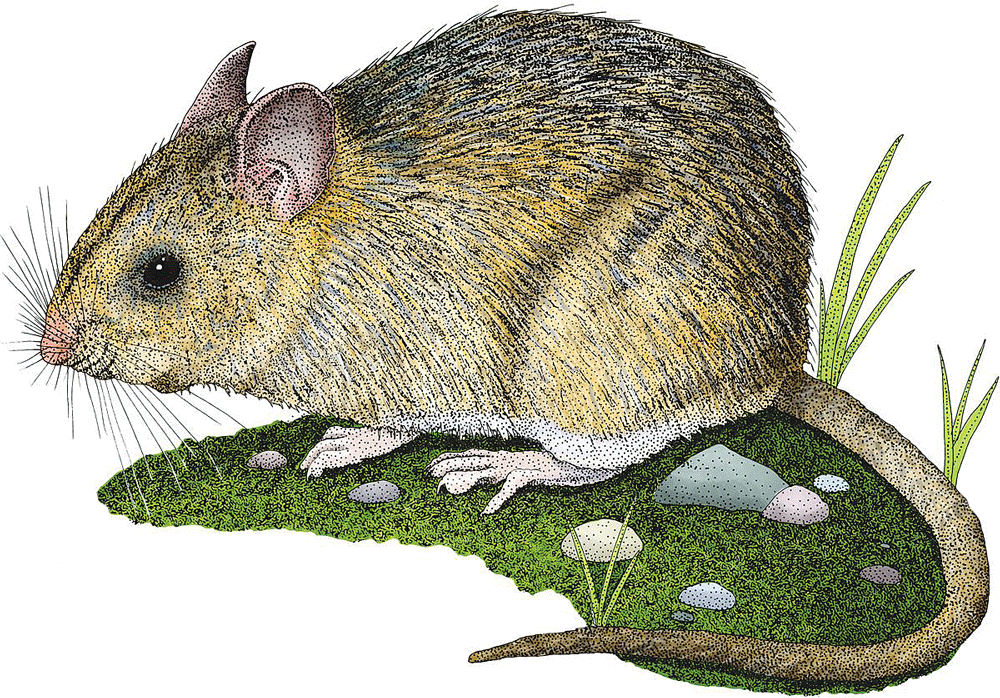Wildlife Notes
The Dusky-footed Woodrat

My goodness!! What chonky little rats we have here in Mendocino. The Dusky-footed woodrat, to be precise, is our most common Mendo rat that lives in the oak woodlands among other places here in our county. They are called “dusky footed” because they have little grey marks that look like soot on their feet, chest, and sometimes adorning their little faces. They build humongous woody mansions that can be up to 5 feet tall with a base of over 3 feet. You will find them in the forests and up in the trees. Their dwellings are extremely organized and tidy. They actually have little separate rooms. One room could be for mushrooms, one for acorns, one is a bathroom, a bedroom, and of course the treasure room, and so on. You may be surprised by the objects you will find in a woodrat home. They like shiny things of all sorts. These houses tend to be amazingly clean, using bay and cedar, which is a natural fumigant and anti-fungal to keep them and their families as healthy as possible. It is the females (does) who build and are the master craftrats here. The eldest female passes the shelter down to her daughter and so on. They also have satellite houses—second-home owners, if you can believe it! They are very clever little rodents. They are also called “Pack-rats” or “Trader-rats,” because they carry things around and if they see something better, they will trade it out for the newfound object. Another name for them is “Bushy-tailed woodrat.” They are mostly solitary but enjoy their neighbors and live together in small villages. The females choose who to mate with, usually favoring the same male companion every year.
So that’s the introduction to our awesome little rodent friend, Dusky-footed WR. They are super cute and one of the main staples in the wildlife pantry. They’re a favorite of foxes, bobcats, coyotes, raptors, and even cougars have been known to have a rat snack or two. They are an integral part of our ecosystem.
Okay, all that said, let’s talk about what a pain they can be and the best possible exclusion tactics. Here are the basics:
- Clean around the house. Don’t leave any trash.
- Thin the trees and bushes near your site, as rats are attracted by thick weaving and ungroomed plants.
- Make sure there are no holes in your walls
- Use exclusion fencing with small gauges
- Go ahead and put fencing around your stalks if they are nibbling to get water
- Peppermint, grow peppermint everywhere, they hate it.
- Destroy their homes
Now, if you need to trap, go ahead and use a live trap. Once you’ve trapped your rat, carry it over a mile away as they have excellent homing skills. It may not survive, but at least it will make a tasty snack or dinner for a furry or feathered somebody out there.
Okay, so you tried that, they’re not buying the live trap and there are a lot of them. If you need to kill some rats, then you’re going to need to buy a snap trap (please don’t use the glue, so mean). Once you’ve dispatched the little guys, make sure you feed them to wildlife. It will be a perfect find for some lucky somebody out there. Always make sure you are thinking of the whole picture for wildlife. I know how you feel sometimes: these rats can take down a lot of your plants, they can destroy your home, mess with your chicken coop, and eat your greens! I get that you feel so mad sometimes you don’t care how they die, just gettum gone! Well, my friends, it’s totally up to us to give a rat’s ass, pardon the pun. We must make our decisions with care. So, bottom line here: DO NOT EVER USE POISON. DO NOT EVER USE POISON. DO NOT EVER USE POISON. I know the other ways are more laborious and time-consuming, but they are a more sustainable solution and will make your soul proud of you. You don’t want to be the one that poisoned the rat and killed the eagle! What about that human that poisoned that rat that killed your neighbor’s cat? Also, remember, look for their houses, you can take them down and make it inhospitable for them, and they will have to invest in some other piece of real estate.
Great News! California just became the first state in the nation to effectively ban rodenticides! On Sept. 29, California Governor Newsom signed AB 1788 into law. This hard-fought bill imposes a moratorium on the use of second-generation anticoagulant rodenticides, thereby saving the lives of thousands of bobcats, coyotes, mountain lions, foxes, raptors, and other non-target species who would have suffered and died, victims to secondary exposure from these deadly rat poisons. Whatever you do, NEVER USE POISON! For more, visit mendowildblog.com.

Traci Pellar has been an advocate for wildlife education and habitat conservation for more than 30 years. She currently serves on the Willits Environmental Center Board of Directors and is the co-founder of the Mendocino Wildlife Association. Stay wild baby!!
